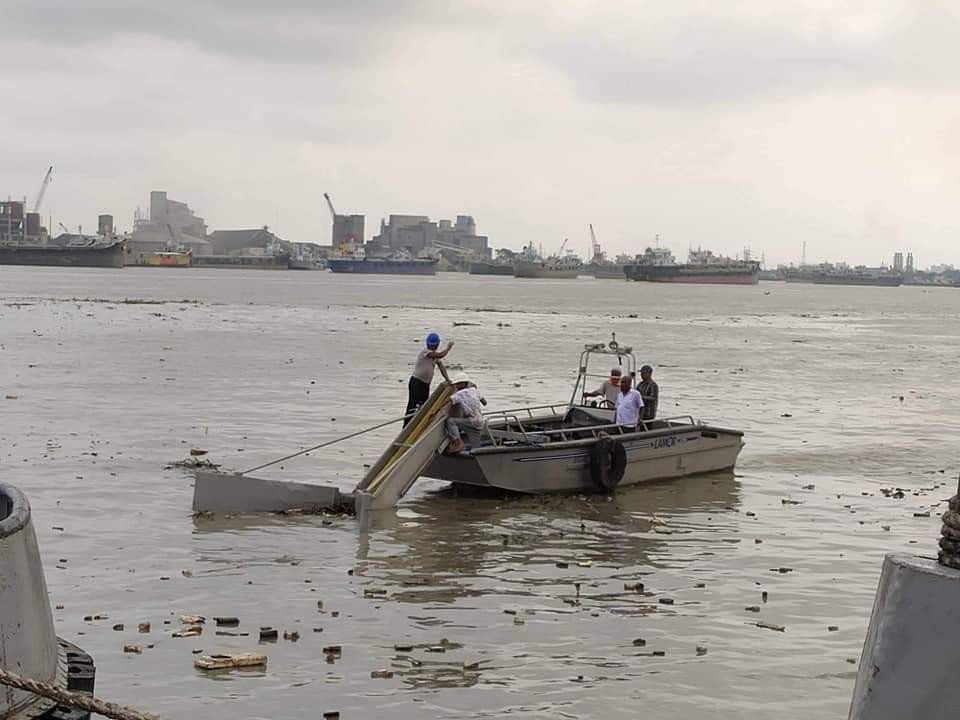Massive oil spill threatens rare dolphins in Karnaphuli
Tides have carried 10,000 litres of spilled diesel across 16 kilometres till the filing of this report

A massive oil spill is threatening the biodiversity in the Karnaphuli River by putting hundreds of fish species and endangered dolphins native to the largest river in Chattogram at serious risk.
The tides have carried 10,000 litres of spilled diesel oil across 16 kilometres till the filing of this report at 7:00 pm on Saturday. Since the accident occurred early Friday, there has been no notable progress in removing the oiled debris from the river.
The fact that the port area is restricted to public has further complicated any cleanup efforts. The Department of Environment is yet to launch any operations in this connection.
According to environmental experts, spilled diesel or any other type oil severely damages the food chain of a river or a canal almost immediately after contamination. The diesel spill in the Karnaphuli River is a threat to the local biodiversity, especially the Ganges River dolphins.

This subspecies of the South Asian river dolphin is locally known as the "Utom" or the "Shushuk."
The International Union for Conservation of Nature has categorised the Ganges River Dolphin as an endangered species. At least 20 dolphins have died in Karnaphuli and Halda rivers in the past four years.
The 22-kilometre stretch of the river from Karnaphuli estuary to Shah Amanat Bridge is the breeding ground of these dolphins. Environmentalists are concerned that the Ganges Dolphin population will be irreparably harmed by the oil spill.
Dolphin researcher Professor Dr Mohammad Al Amin of The Institute of Forestry and Environmental sciences, University of Chittagong said, "The massive oil spill caused by the tanker accident in the Karnaphuli River will threaten the very survival of these dolphins.
"The oil spill is causing oxygen depletion in the water, which has led to breathing problems of these dolphins. Microbes and fish living in the top levels of the river will be wiped out."
Ganges dolphins of Karnaphuli
Dr Mohammad Al Amin was also involved in a research to determine whether the construction of a new jetty in the Karnaphuli River would be detrimental to the dolphins and other native aquatic animals.
The research was conducted from February to April of 2017, on the Karnaphuli River estuary by dividing the region into four zones. A total of 920 dolphin sightings were recoded.

An adult male Ganges Dolphin can reach lengths up to 2.12 metres and females can grow even larger. The dolphins have a grey complexion, round underbelly and feature a long nose and mouth.
The subspecies can live for up to 30 years, but their birthrate is low compared to the other species.
What caused the oil spill?
Around 10,000 litres of diesel spilled into the Karnaphuli River when an oil tanker hit a lighter vessel after losing control early Friday.
Khulna bound oil tanker Desh-1 hit lighter vessel City-38, anchored at Padma jetty of the Port of Chittagong, at around 3am which caused a leak in the third tank of the tanker. Carried by the high tide at the time, the oil spill quickly spread through the river from the scene of the accident.
Clean up vessels Bay Cleaner 1 and 2, Kandari 10 and 11, and Skimmer 1 and 2 have removed 8,000 litres of water mixed with oil until Saturday.
The Business Standard visited the scene and found access to the Dolphin Jetty area restricted. However, traces of the massive oil spill throughout the river can be seen from afar.
Spilled oil can also be seen in many areas adjacent to the riverbanks. Traces of spilled oil can be found as far as five kilometres away from the scene of the accident.
Oils spills in Karnaphuli
In July, 2016, collision between two oil tankers at the Port of Chittagong caused around 150,000 litres of diesel to spill in the Karnaphuli River.

On February 1 the same year, a vessel carrying palm oil was involved in an accident at the same port, spilling around 60,000 litres of oil in the river.
Several oil spills were caused by accidents involving trains carrying furnace oil through areas such as Hathazari, Karnaphuli River and Shikalbaha canal of Boalkhali.
Addressing the issue, Md Omar Faruk, secretary of Chittagong Port Authority said, "We are working tirelessly to clean up the oil spill. The Department of Environment has been contacted to assess the damage to the local environment and biodiversity."
Meanwhile, Department of Environment Director (Chattogram region) Moazzam Hossain said, "I am aware of the oil spill. The port has seized the two vessels involved in the accident.
"This is an internal matter of the port authority and the department will step in if they ask for our assistance on the matter."



 Keep updated, follow The Business Standard's Google news channel
Keep updated, follow The Business Standard's Google news channel
















